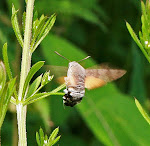.jpg)
August 11, 2010:
Following a lack of improvement to the dismal summer weather locally, the forecast for some decent conditions in southern England prompted a day-trip to the Chiltern area to see the Silver-spotted Skipper (Hesperia comma).
This is a relatively rare butterfly in Britain and is at its north-western European limit in southern England. Aston Rowant, close to where the M40 motorway cuts a deep groove through the chalk hill-side, is one of its strongholds and is the most northerly British colony of any size.
.jpg)
.jpg)
.jpg)
This is a late-emerging, single brooded butterfly not on the wing until late July but which then continues to fly throughout August. It is restricted to warm, south-facing slopes on chalk downland where the turf is kept short by grazing and its larval food-plant, Sheep’s Fescue, grows. At Aston Rowant, on the steep warm hillside, there were many small bare patches of chalk presumably exposed by rabbits and it was on these warm areas that the butterfly sometimes basked. However, once the sun went in they would cease to fly but would immediately resume on its return.
.jpg)
.jpg)
[Basking over warm patches of chalk exposed by rabbits]
The butterfies flew fast and low and being of a dull greenish-ochre colour below were hard to follow. However, once settled the prominent silver spots, especially noticeable on the underside of the hind wing, could be seen. The females were darker in colour than the males, the latter having a line of dark scent scales on the forewing similar to some other skippers such as the Large Skipper. A wide range of nectar plants were apparently used but thistles and composites were probably the most favoured. There must be a very large population here as they were regularly encountered over most areas of suitable downland.
.jpg)
[A heavily marked female, above]
.jpg)
Although the most frequent skipper was the Silver-spotted, a few Essex Skippers (Thymelicus lineola) were also seen. These are much more widespread in Britain and nothing like as scarce. The Essex can be distinguished from the very similar Small Skipper by having black tips to the underside of their antennae (rather than brown as in the Small). Also, they have a shorter line of dark scent scales running parallel to the outer edge of the fore-wing, not longer and angled away as in the Small.
.jpg)
.jpg)
[Essex Skippers, showing the black underside to the antennae and characteristic line of scent scales]
.jpg)






Glad you finally made it down to Aston Rowant it's a great place for butterflies at the moment as you know. Some nice looking shots of both the Skippers, Grizzled Skippers are also reported at the reserve which are flying at the moment but I'm not sure of their numbers.
ReplyDelete